
The Gods of Heavenly Punishment is Jennifer Cody Epstein’s second novel. Her first, The Painter from Shanghai, imagined the life of Pan Yuliang, a Chinese painter of perceptive and richly decorative nudes. The novel unscrolls the painter’s development against a number of political-historical canvases, from her early life in a Shanghai brothel through to mid-20th Century Paris.
In her new novel, Cody Epstein searches into another overlooked corner of recent history: the firebombings of Tokyo, as experienced by four radically different people: Cam, a young American fighter pilot; Anton, a European architect working in Tokyo; Billy, Anton’s son, an Occupation soldier and a talented photographer; and Yoshi, a young Japanese girl who comes of age during—and because of—the war. The book is structured as a web of intimate portraits, so that we see each of these characters from inside and out. Their lives intersect in strange ways, some deliberate, some accidental, such that the plot itself is driven not only by large, distant political decisions, but also by these individuals’ desires, ambitions, and weaknesses.
***
The Rumpus: The first thing I want to know, even though I’m sure you’ll end up talking about this a lot, is how you came to want to write about this particular, complicated moment in Japanese and American history.
Jennifer Cody Epstein: I have long been fascinated by Japan. I was an exchange student, then a university teaching fellow, and finally a journalist there in the ’80s and ’90s, and have studied its language, literature, and history both as an undergraduate and graduate. So it was an obvious place to set a storyline for me. Initially, though, I was a little daunted by the idea of writing about it. I think my hesitation stemmed from a place similar to my hesitation to approach memoir—I find it very hard to write about things that are close to me (my motto seems be “write what you don’t know”), and as a place, Japan has figured so prominently in my life, and provided so many complicated and rich experiences, that I think I needed a very clear prompt to re-enter it. At least literarily.
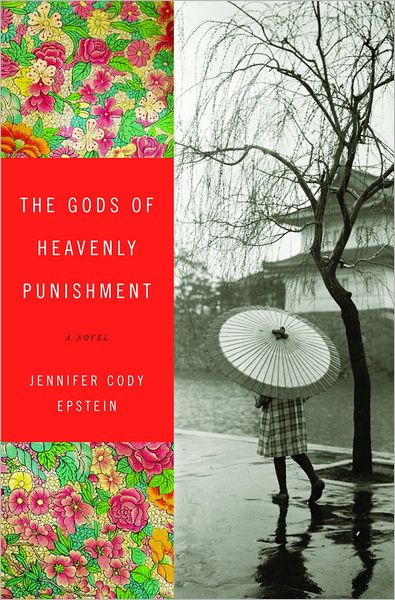 That prompt ended up coming from my husband (as, incidentally, did the prompt for my first novel—he’s kind of an ideas savant). For nearly a decade he’s been working on a documentary about the 2005 Haditha massacre in Iraq, and around the time I was casting around for my next novel idea, he was interviewing a military lawyer about the trial that resulted from the killings. The talk turned to how one defines a war crime, and the lawyer brought up the Tokyo firebombing as an example of something that would by today’s standards fit that definition. I was immediately intrigued; in part because, despite all of my academic studies of and personal time in Japan, I really didn’t have an immediate sense of what those bombings were. Like most people, I tended to think of Hiroshima and Nagasaki when I thought about America’s air campaign against Japan.
That prompt ended up coming from my husband (as, incidentally, did the prompt for my first novel—he’s kind of an ideas savant). For nearly a decade he’s been working on a documentary about the 2005 Haditha massacre in Iraq, and around the time I was casting around for my next novel idea, he was interviewing a military lawyer about the trial that resulted from the killings. The talk turned to how one defines a war crime, and the lawyer brought up the Tokyo firebombing as an example of something that would by today’s standards fit that definition. I was immediately intrigued; in part because, despite all of my academic studies of and personal time in Japan, I really didn’t have an immediate sense of what those bombings were. Like most people, I tended to think of Hiroshima and Nagasaki when I thought about America’s air campaign against Japan.
But when I started my research, I was floored to discover that the March 9-10 firebombing of Tokyo was—initially, at least—more devastating than Hiroshima. Over a hundred-thousand people died that night, as compared to 80,000 initial deaths in Hiroshima and 50,000 in Nagasaki (or, for that matter, Dresden’s 30,000). So why, I wondered, did the firebombings come up so rarely in our discourse about the Pacific war? That vacuum made me curious—both to explore the event as an experience, and to ponder its greater ramifications during and after the war.
Rumpus: Many objects in this book externalize or concentrate your characters’ emotions, from the ring that Cam’s young bride gives him, to the thousand-stitch belt that Yoshi makes for her young man at the front, to her friend Satako’s bicycle. Yoshi is rushing through Tokyo’s streets on its handlebars when the bombing begins. The bike lands across the street and when Yoshi sees it—upside-down, blackened, melting—its dissolution is her city’s, her life’s. Even the bombs themselves, or houses, or planes—can you talk more about how the factual impermanence of things belies your characters’ hopes for longevity?
Cody Epstein: I suppose it relates to our tendency to symbolize, to imbue physical objects with associations far beyond their objective functionality—and subsequently see their fates as intertwined with our own. The Japanese seninbari—thousand-stitch belts—were quite literally intended as symbols of longevity, in that it was believed that if a thousand different women each placed a single French knot on a belt, it would serve as an amulet against death for a soldier. But even objects not specifically crafted as symbols often end up becoming them anyway. Especially, I think, in literature, where they provide useful tools for highlighting a story’s themes and lessons. When Yoshi glimpses the tires of her best friend’s bicycle melting amid the inferno, for example, she has a fleeting image of herself as a child, turning her tricycle upside down to play with it that way. She’s fifteen at that moment, and by that point her childhood has been largely sacrificed to the greater objective of simply surviving. But this is a moment where she perhaps officially recognizes that it is gone—along with her primary means of escape.
Likewise, when the bomber pilot Cam finds himself at the hands of his Japanese captors, he instinctively feels for his wife’s ring as a kind of token of normalcy and permanence. When he doesn’t find it, it serves as terrifying affirmation that his own fate truly hangs in the balance.
Rumpus: What about the role of photography in the book? Each of its sections is prefaced with a poignant, WWII vintage photo. The first time we see Billy, he has been given a camera, and one of the book’s final scenes involves a gallery display of his photos, taken in Tokyo just after the firebombing, an eloquent gesture of trying to see, trying to know, across cultures and languages and, now, time. How did photography come to figure so centrally in the book’s conception?
Cody Epstein: Part of it is due to the fact that World War II was the first American war to be so extensively documented by photography. Because of this, many of us tend to add a sort of grainy, black-and-white texture to our thoughts and musings on the period, and I wanted to play with that association a little—particularly when I realized how striking some of those images I was uncovering for myself were.
Then there was the fact that many of the things I was trying to describe were actually rather hard to visualize without a picture—a Japanese tenement house in the middle of a Midwestern desert, for example. Or a ten-ton bomber lumbering down a breathtakingly short runway, on an aircraft carrier meant for tiny fighter jets. Finding those images really added dimension to my understanding of those moments. I thought it would do the same for my readers.
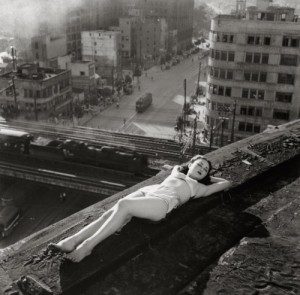 I also felt that the work of one photographer in particular—Hayashi Tadahiko, who took the “Dancer on a Rooftop” image that appears at the very beginning of the book—was just so beautiful and evocative and, in its own way, subversive, that I really wanted to share it with readers—as well as model Billy’s photographic sensibilities upon it. In the end, in fact, those images were part of why I made Billy a photographer—that, and because I believe art to be a powerful, redemptive force, something that helps us (in Hirohito’s words) to “bear the unbearable.” That’s a theme I also explored in The Painter from Shanghai. As I fictionally retraced traced Pan Yuliang’s rise from prostitute to post-impressionist icon, I was trying to understand what role art played for her in that extraordinary transformation. Not just for her professionally, but in terms of her physical and emotional survival.
I also felt that the work of one photographer in particular—Hayashi Tadahiko, who took the “Dancer on a Rooftop” image that appears at the very beginning of the book—was just so beautiful and evocative and, in its own way, subversive, that I really wanted to share it with readers—as well as model Billy’s photographic sensibilities upon it. In the end, in fact, those images were part of why I made Billy a photographer—that, and because I believe art to be a powerful, redemptive force, something that helps us (in Hirohito’s words) to “bear the unbearable.” That’s a theme I also explored in The Painter from Shanghai. As I fictionally retraced traced Pan Yuliang’s rise from prostitute to post-impressionist icon, I was trying to understand what role art played for her in that extraordinary transformation. Not just for her professionally, but in terms of her physical and emotional survival.
Rumpus: We learn the source of the book’s wondrous and intriguing title amid the mayhem of the firebombings themselves:
The second round of bombs fell in much larger bundles, slow as dreams, bright as water. But when they landed—everywhere at once, it seems; in a single smoking heartbeat—the ground shook. It felt like an earthquake. In an instant, both girls were on the ground. Yoshi felt her teeth slam together. She tasted blood and soot and, after that, something astringent. Pain burst out somewhere towards the back of her jawline. Hand to cheek, she disengaged herself from Satako and tried to scramble back to her feet. Then another cluster landed, this one directly across the street from them. She dropped back down, clutched at her ears.
This device, however, didn’t explode right away. Watching it through the small shaking space between her elbows, Yoshi saw it spit something out; a thick wet jet. The air seemed silent in that moment; a hushed space of ash, the stench of gasoline and dread. After an absurdly long wait it came: a booming flash, a roar so deafening that the screaming world went quiet.
Yoshi’s ears were still ringing when the heat hit her with the force of a flung boulder. It blistered her lips, sealed her eyes shut like melted wax. I’m dead, she thought. But she wasn’t, she was still standing. Prying her eyelids apart with trembling fingers, she blinked: everything in her vision was in flames. As her sight adjusted she heard a loud crack, a hiss, a groan—as though some huge beast had just been dealt its death blow. The house directly behind them leaned drunkenly to the right, then collapsed, releasing a fountain-like spray of burning embers. A woman screamed, and Yoshi turned to see the suitcase-lady. Her fur collar and hair were in flames, which quickly spread to the synthetic stockings on her legs. Yoshi’s last sight of her was like something she’d seen once in an old painting in a temple; something their teaching had called a “Hell Scroll.” Entitled The God of Heavenly Punishment, it showed a huge, fiery demon consuming tiny people limb by limb, surrounded by more flames and staggering, fire-limned figures.
Could you say a little more about that scroll, about what sort of cosmology it represents, and perhaps its relationship to the book’s events or to Yoshi’s worldview?
Cody Epstein: The God of Heavenly Punishment is one of several so-called “Hell Scrolls” painted in the 12th Century, depicting a variety of divine retributions based on Buddhist lore. The scroll from which I took the book’s title shows the demon Tenkeisei consuming the ox-headed deity Gozu Tenno, who is the god of pestilence. There is really more blood than flame in the real scroll (actually, it may all be blood!), but I added some of the flame imagery from other Hell Scrolls to Yoshi’s recollection of it, because the ideas represented by the paintings—divine righteousness, fiery retribution—seemed deeply woven into the national perspectives on both sides of the war, and so vividly present at the moment of the bombing itself. Up until that point, most Japanese truly believed Hirohito was an ikegami, a “living god,” and that their mission was to help him spread Asian dignity and honor throughout the East after centuries of Western oppression (though of course what they ended up spreading was something else entirely). For their part, the Americans—as the innovators of the world’s most advanced and devastating aerial technology at that time—were certainly putting themselves in a godlike position as they incinerated city after Japanese city in the conflict’s final months.
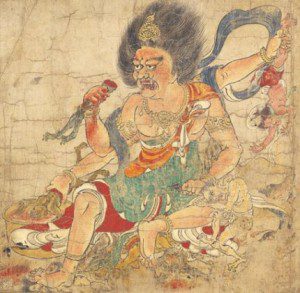 Yoshi’s own journey reflects a shifting of the balance between the Japanese and the American “gods.” As a child, she—like every other Japanese student—memorizes the Emperor’s divine lineage the same way we memorize our multiplication tables. And when she travels to Northern China (which the Japanese invaded and occupied from 1930 onwards), she initially believes that she is witnessing the proof of Japan’s divine imperative to “help” the less divinely-blessed Chinese.
Yoshi’s own journey reflects a shifting of the balance between the Japanese and the American “gods.” As a child, she—like every other Japanese student—memorizes the Emperor’s divine lineage the same way we memorize our multiplication tables. And when she travels to Northern China (which the Japanese invaded and occupied from 1930 onwards), she initially believes that she is witnessing the proof of Japan’s divine imperative to “help” the less divinely-blessed Chinese.
As the war drags on however, she begins to see the holes that wear through in this mythology: how the Japanese in Northern China are not leaders there but oppressors, whose “divine mission” is really methodic pillaging. How the Emperor allows torture and totalitarianism in his name at home. And ultimately, how for all his supposed divinity, he is helpless to protect her city or her people when American bombers shower Tokyo with napalm and flame.
In the war’s wake, it is the American “gods” who will shape Japan’s fate; forcing Hirohito to reveal himself as a mere human after all. Deciding who will be condemned at the Tribunal and executed. Deciding precisely what shape the new Japan will take as it emerges from its years of occupation—very much in America’s own image.
Rumpus: It also just occurred to me that both you and I, in our first novels, fictionalized the life of a defiant woman in a traditional society, while in my second book, I, too, have tried to address a public act of political violence. Writing my second novel made me exquisitely attuned to what it means to evoke real violence in our fiction. Typing out that passage of your writing, above, I couldn’t help noticing the way you use—or omit—punctuation for pacing, your adjectival choices, your laden yet deadpan delivery of details.. How would you characterize your approach, and what did you go through when writing scenes such as this and the other instances of brutality and horror shown in your book?
Cody Epstein: I think my approach was to try to understand the full horror of the war by immersing myself in it from both perspectives; to see it not in political or even moral terms, but in terms of its incalculable human toll. Having never been in an actual war myself (though we did see the second plane hit the World Trade Center from our Brooklyn window), it was obviously a little daunting to try to envision the sights, smells, physical sensations, and emotions experienced in one. But that, in the end, is the real challenge of writing: you have to trust your empathy and imagination to take you someplace that will ring true—even if it isn’t based on personal experience.
In terms of what I went through writing it: there were many things. Anxiety over somehow getting it “wrong.” A kind of electricity as I finally just wrote the stuff. And afterwards often finding myself drained; in a sort of numb and empty place that I’d try to balance out by drinking bourbon with my husband, or hugging my kids, or playing with my dog.
Rumpus: This is a huge question, but please bear with me, and correct my understanding if you think I’ve gotten it wrong: how did you come to feel about the moral balances in the book, as conveyed through your characters? In particular, how did your understanding of the faults and decisions on each side evolve as you worked on the book? While we see the damage inflicted by the American bombs Cam drops, this role of his was official, whereas the Japanese who take him prisoner are violating Geneva Conventions. It obviously is wrong to bomb civilians, but that particular ill is still widespread, and wasn’t, I think, outlawed until post-WWII. In other words, the Japanese come across as brutal and benighted by our standards. No American is shown committing war crimes. Individual racism seems about equal on both sides. The spoils of Japanese-American homes evacuated by internment are used to furnish Anton’s model home, but that’s about all we get of systemic American wrongdoing, and it’s not technically illegal. What I took away was that, even despite the horror of the firebombing, the Japanese had to be stopped, much as the Nazis did. To portray Nazis as evil is something we take for granted, however, while showing the Japanese, or their military, that way must have been tougher, I imagine, not least because of the vexed question of race, and because of the nuclear bombings. Am I way off-course?
Cody Epstein: Not at all. Those are actually the types of things I asked myself many times as I worked my way through the book, and finding objective answers to them was elusive, to say the least. In fact, I really can’t pretend to have done that—only to have explored the questions.
For me, part of that exploration involved questioning what we mean when we use terms like “evil” and “crime.” Defining either can be a murky task, but is especially so in wartime. I think, for instance, that it’s dangerous to use a blanket label like “evil” when thinking about an enemy—even in as egregious an example as the Nazis. In doing so, you risk distancing yourself to the point of losing sight of the potential universality of what happened in Germany. Yes, there were men in charge who were clearly monsters. But the greater problem was the German population—millions of Germans who considered themselves decent, moral human beings, who ended up following the Nazi agenda. They followed it not because they were intrinsically “evil,” but because they allowed themselves—be it through action or apathy—to be steered by national policies that carried sickening moral and human consequences. In the end that’s what the Japanese did as well, albeit on a different scale and to a different populace—so if you’re going to argue that one is “evil” you probably need to argue it for both, regardless of race or eventual fate. But in my opinion, what’s truly important to remember is just how easily—even casually—that evil occurred. And that it can occur again any time, in any nation (ours included), and at the hands of people who in all other respects are just like the rest of us.
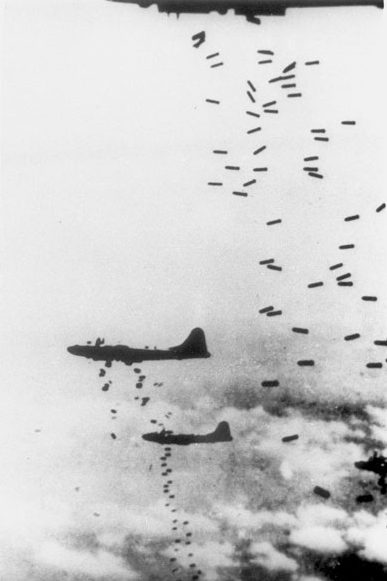 Likewise, “crime” can become a very slippery term—particularly when it comes to air power (as the ongoing debate over its next phase—e.g. drones—attests to). My sense of the fire bombings, both in Germany and in Japan, was less that they were considered “legal” or “illegal,” than that there was no clear legal framework yet established for them. The U.S. military essentially made up both the technology and the rules as it went, and by that point no one was going to stop them. And as Max Hastings writes in Retribution, the decision to “bomb and burn ‘em till they quit” really came down to a small handful of military leaders, with no weigh-in on the presidential level, and certainly no commentary from the U.K., which had long been doing blanket area bombing in Germany (a fact which, incidentally, I think partially addresses the “vexed” race question).
Likewise, “crime” can become a very slippery term—particularly when it comes to air power (as the ongoing debate over its next phase—e.g. drones—attests to). My sense of the fire bombings, both in Germany and in Japan, was less that they were considered “legal” or “illegal,” than that there was no clear legal framework yet established for them. The U.S. military essentially made up both the technology and the rules as it went, and by that point no one was going to stop them. And as Max Hastings writes in Retribution, the decision to “bomb and burn ‘em till they quit” really came down to a small handful of military leaders, with no weigh-in on the presidential level, and certainly no commentary from the U.K., which had long been doing blanket area bombing in Germany (a fact which, incidentally, I think partially addresses the “vexed” race question).
Those orchestrating the bombings acknowledged that civilians would be killed, but tried to balance it out morally by noting that Japan’s war industry was both small-scale and deeply enmeshed with the city’s residential neighborhoods. “The entire population got into the act and worked to make those airplanes or munitions of war,” Curtis LeMay asserted later. “We knew we were going to kill a lot of women and kids when we burned that town. Had to be done.” As Hastings also points out, he and the other architects of the bombings conveniently overlooked the fact that the U.S. Naval Blockade had already effectively strangled Japan’s military industrial complex by 1945.
To be sure, LeMay’s seeming casualness about the hellfire he unleashed doesn’t obviate the fact that the Japanese, like the Germans, were clear aggressors in World War II, and clearly did need to be stopped. Nor does it change the fact that, unlike the Germans, an entire Japanese generation had been raised to see death as the preferable alternative to defeat—and was prepared to fight to the very last man, woman, or child. There is little question that more American lives and many more Japanese lives would have been lost in a land invasion than were lost in America’s air campaign, however brutal it was.
There is, however, a very large question for me when it comes to the extent and execution of that campaign. Whatever they might have said publicly, LeMay and his colleagues knew full well that in firebombing sixty-seven of Japan’s major cities, they were sentencing hundreds of thousands of Japanese civilians to horrific deaths—for the sake of a military objective that was, at best, negligible. They also knew—from experiences like the London Blitz—that traditional area bombing can just as easily boost enemy morale as crush it. So the looming issue becomes less one of whether it was “legal,” than whether it was worth the human and moral cost—especially given that, unlike the atomic bombings of Hiroshima and Nagasaki, there is no obvious evidence that the firebombings brought Japan any closer to surrendering.
That also isn’t a question I can or even seek to answer in my book. But I think it’s one that needs to be considered.
Rumpus: In the last pages of the book, Yoshi, flying into America for the first time, looks out on the shining wonder of mid-century L.A. and thinks to herself, No wonder. No wonder we lost. This struck me as a bold and brilliant stroke on your part, setting the illusory wonders of America’s ascendancy against Yoshi’s visceral experiences of death and destruction—not least of the traditional, hierarchical, and in many ways bankrupt culture that her own mother rejected. Can you elaborate on your process in creating Yoshi? What did it mean to have her straddle Japan’s before and after, such that, in many ways, she belongs to neither?
Cody Epstein: That phrase came from a firebombing survivor that I interviewed in Tokyo—an extraordinary woman who lost her mother and six siblings to the March 9th bombing (she later lost her seventh and last sibling in a separate bombing), and in the decades after became a vehement voice for peace. She visited America in the ’60s for the first time, and told me that that was her very first thought after getting off of the plane and seeing how enormous and modern everything was: No wonder we lost. The words really chilled me—in part because they demonstrated how little most Japanese understood what they were getting into when their military bombed Pearl Harbor. For the majority of the population, the war was simply an extension of the Imperial divinity myth upon which they’d been raised—completely ungrounded in the realities of military capacity.
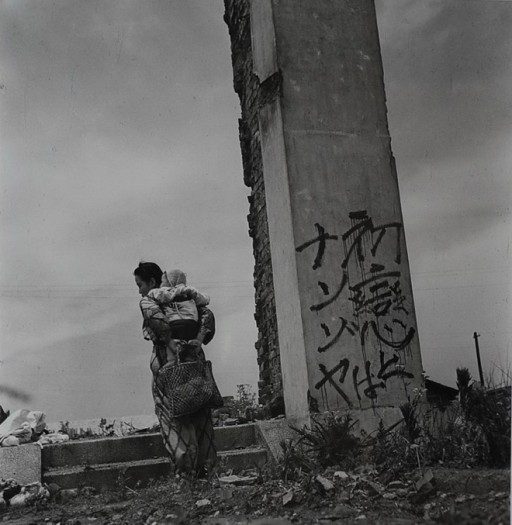 I’d already written a fair amount of Yoshi’s story by the time I jotted the phrase down in my notebook, but for me it helped crystallize what that moment would be like for her, upon first seeing this nation that had so defined hers during and after the war. In terms of the rest of the creation process…I’ve always been fascinated by the ways in which different cultures can intersect and/or clash, and in the process come away changed. It was something I explored in Painter (the turning point at which Chinese art found itself in the wake of China’s internationalization; the mix of fascination and revulsion with which many Chinese viewed the Western aesthetic). And so I think it was natural that that theme carried over into my exploration of Japan—particularly since I was interested in showing the war from both sides. Having characters who understood both Japan and the West was a way to explore the conflict in a more nuanced and less jingoistic way.
I’d already written a fair amount of Yoshi’s story by the time I jotted the phrase down in my notebook, but for me it helped crystallize what that moment would be like for her, upon first seeing this nation that had so defined hers during and after the war. In terms of the rest of the creation process…I’ve always been fascinated by the ways in which different cultures can intersect and/or clash, and in the process come away changed. It was something I explored in Painter (the turning point at which Chinese art found itself in the wake of China’s internationalization; the mix of fascination and revulsion with which many Chinese viewed the Western aesthetic). And so I think it was natural that that theme carried over into my exploration of Japan—particularly since I was interested in showing the war from both sides. Having characters who understood both Japan and the West was a way to explore the conflict in a more nuanced and less jingoistic way.
So even from her first inceptions Yoshi was a very Westernized Japanese girl. In my very early drafts, in fact, I had her dancing the tango in Ueno Park and humming in Portuguese (my editor, very wisely I think, put the kibosh on that). As her character took shape, I realized that her internationalization would have to come from a pivotal figure in her life. That figure turned out to be her mother, whom I initially also made a Tango star (okay, so I was a little obsessed with Tokyo’s prewar Tango boom) but in the end, based on a character I read about in a fascinating memoir by Helen Mears, The Year of the Wild Boar. In it, Mears—an American journalist who lived in Tokyo for the year of 1935—relates meeting a Japanese woman who’d been sent to British boarding school for a decade by her parents, then brought back with the intention of marrying her off as a traditional Japanese wife. That dilemma really intrigued me—that someone could have been shaped by Japan’s internationalization period, but then trapped back in her own country when it turned xenophobic and anti-Western. It struck me as a good way to give Yoshi the dual perspective I wanted her to have while exploring what that sort of trauma might do to someone’s identity and psyche.
And as you note, creating Yoshi as someone who straddled both East and West was also a way to give her a unique perspective on the evolution of the U.S./Japan dynamic. She is Japanese enough to be acutely aware of the hypocrisies and prejudices of the American occupiers. But she also has the objectivity required see her own nation’s transgressions and failures—as well as its single-minded determination to move beyond defeat and loss, and into a new era of reconciliation and alliance. Ultimately, it’s the same journey her character will make as well.
***
Photographs: “Dancer on a rooftop” and “Mother and children in a war-devastated area” © 1947 by Tadahiko Hayashi.




